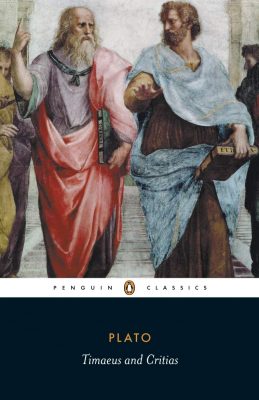Timaeus is a dialogue by Plato written in 360 B.C. Much of the contents of this dialogue come in the form of a one-man discussion done by the Pythagorean philosopher, Timaeus of Locri. The work contains a large number of concepts about how the physical world works, what it is made out of, and about human beings. The characters involved in the dialogue are Socrates, Timaeus, the political figure and author, Critias, and the Syracusan general, Hermocrates.
Timaeus starts with an introduction wherein Socrates, after having described his perfect society, asks his guests if they know of a story about such a perfect society. Critias responds to him, narrating that while Solon the Statesman was in Egypt, he heard a magnificent story about Atlantis and how the perfect state of Athens went to war against Atlantis. However, Critias explains that Timaeus will first narrate a part of the story about the beginning of the universe.
The Physical World and the Eternal World
Timaeus opens the story by explaining how the physical world differs from the eternal world. He says that the physical world is continually undergoing destruction and change and whatever is said about the physical world is merely opinion and the product of sensations. In contrast, the eternal world is unchanging and can only be understood by reason. Timaeus further says that because of this, depictions of something that is constantly changing will also be constantly changing and unreliable, while depictions of an unchanging thing will also be unchanging. Timaeus then argued that since nothing comes into being without any cause, then the universe must have been caused into being by something. This something must be a god, or a demiurge, who is the father of the universe. Timaeus points out that since the universe is just, the demiurge must have created the world from its original state of disarray, based on the eternal world with its eternal ideas or Forms.
The Driving Force of the Universe
According to Timaeus, the demiurge is a good being and therefore wanted the world to be full of goodness. The demiurge then determines that goodness is to be established by bringing order to the world. To bring about this order, the demiurge introduced the goddess of necessity, Ananke, into the world. Therefore, Ananke sets in motion the element of inevitability.
Characteristics of the Universe
Timaeus describes the initial stage of the world as chaotic. The four elements, which are earth, fire, air, and water, were formless and intermingled continuously with each other. The demiurge considered formlessness and disarray to be undesirable, and so he caused the world to be orderly and separated the four elements from each other. With this act, the demiurge created all the goodness and non-goodness, establishing the duality of good and evil. After this, the demiurge proceeded to place intelligence in the soul, and house the soul into body. As a result, the world has become a living entity, animated with intelligence and soul breathed into it by the demiurge. The demiurge wanted the world to be a perfect copy of the eternal world, and so he did not see a reason to create other worlds. The world was cast by the demiurge in the shape of a globe because the globe is the perfect shape that represents all other figures. After assigning the world its globular shape, it was set off into its circular motion, a motion that the demiurge considers the closest one to intelligence. To complete his creation, the demiurge created the world’s soul, planted it in the center of the world, and caused it to spread in all directions. With a soul and intelligence, the world is now a god in itself.
Formation of the World-Soul
Timaeus proceeds with his narration, by discussing the three elements. The three elements are the two forms of sameness, the two forms of difference, and the two forms of being. Three compound essences come from three elements: Intermediate being, intermediate sameness, and intermediate difference. The world-soul is said to have come from these compound essences. The demiurge then proceeded to slice the compound along its length, placed the two halves in the middle in the form of the letter X, and attached the ends together, resulting in two circles that crossed each other. The axes of these two circles were then given an initial push by the demiurge, setting them off in a circular motion. The outer circle was pushed to the right on a horizontal plane, while the inner circle was pushed diagonally to the left.
Next, the demiurge set the heavenly bodies in motion, with the sun, mercury, and Venus moving at the same speed, while Mars, the moon, Jupiter, and Saturn moving at different speeds. The movements of these heavenly bodies repeat after one year and are a perpetual process. After discussing the movements of the heavenly bodies, Timaeus speculates on the shape of the four elements. He imagines the earth to be a cube, the water to be an icosahedron, the fire to be a tetrahedron, and the air to be an octahedron.
Influence
Despite the modern world’s dislike of Plato’s abstract concepts in the Timaeus, it heavily influenced the church fathers in late antiquity, especially Saint Augustine. It was translated in 45 B.C. into Latin by Marcus Tullius Cicero, and again in the 4th century by the philosopher Calcidius. The Timaeus was also held in high regard by Arab-speaking peoples around the 10th century.
